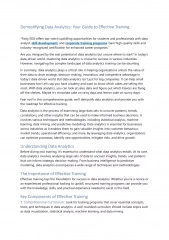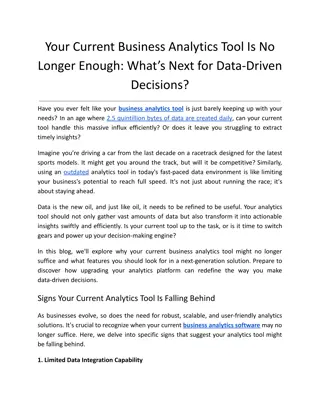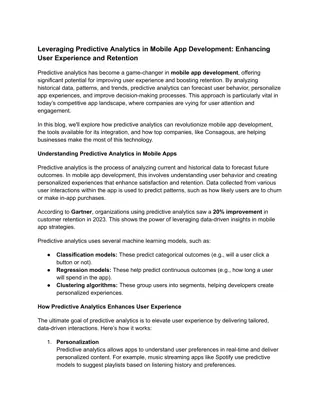
Why Most BI Reporting Tools Fail at Real-Time Analytics
Explore the common challenges that many Business Intelligence reporting tools face with real-time analytics in this insightful blog. We delve into why traditional BI reporting tools struggle with data volume, velocity, and integration, often leading to delayed decisions and competitive disadvantages.
Download Presentation

Please find below an Image/Link to download the presentation.
The content on the website is provided AS IS for your information and personal use only. It may not be sold, licensed, or shared on other websites without obtaining consent from the author. If you encounter any issues during the download, it is possible that the publisher has removed the file from their server.
You are allowed to download the files provided on this website for personal or commercial use, subject to the condition that they are used lawfully. All files are the property of their respective owners.
The content on the website is provided AS IS for your information and personal use only. It may not be sold, licensed, or shared on other websites without obtaining consent from the author.
E N D
Presentation Transcript
Why Most BI Reporting Tools Fail at Real-Time Analytics ------------------------------------------------------------ As leaders, how often do we find ourselves deeply immersed in the hustle and bustle of our day-to-day operations, working closely with our teams to navigate the complex landscape of business data? Do you ever stop to wonder if you're really making the most of the vast amounts of data at your disposal? Consider the experience of John Hawkins, founder and owner of Hawkins Law Firm, a seasoned personal injury and worker s compensation firm in South Carolina. John and his team were no strangers to data; they had it in abundance. Yet, he openly admits, Before Grow, it was a challenge trying to use the large amount of data that we had available to us. They had the data, but the clarity and insights were missing. Their struggle isn t unique. Like many businesses, they knew that visualizing their data could unlock understanding and drive strategic action but how? This is where the tool 'Grow' stepped in, transforming not just the Hawkins Law Firm but offering a glimpse into why many BI reporting tools fail at real-time analytics. Grow didn t just collect data; it made data instantly understandable and actionable. We were immediately able to track leads and status on current cases, Hawkins reveals. Suddenly, the entire team from attorneys to finance members were not just seeing data but interacting with it in meaningful ways to stay on target with their goals. Why do most BI reporting tools fall short where Grow succeeds? Many tools can gather and report data, but they falter in real-time processing and visualization, failing to offer the insights that businesses need when they need them. Let s delve deeper into this issue and discover how we can overcome these common pitfalls in BI reports to make real-time analytics a basis of successful business intelligence. What is Real-Time Analytics In business intelligence, real-time data analytics refers to the ability to process and analyze data as soon as it enters the system, providing immediate insights and enabling instant decision-making. Unlike traditional methods that involve periodic
updates, real-time analytics ensures that BI reports are always updated with the latest data. This capability is crucial in dynamic environments where conditions change rapidly, such as financial markets, online retail, and supply chain management. Real-time data processing in BI reporting is marked by several distinctive characteristics: 1. Speed and Timeliness: The foremost attribute of real-time analytics is the speed with which data is processed and made available. It's not just about fast processing but also about minimizing the latency between data creation and data usability. 2. Continuous Analysis: Unlike batch processing, which runs at scheduled intervals, real-time processing involves continuous analysis of data streams. This ongoing process ensures that the data available in Business Intelligence reports is reflective of the most current state of affairs. 3. Automated Triggers: Real-time systems often utilize triggers that automatically initiate actions based on specific data patterns or thresholds. For example, in fraud detection, a transaction that seems unusual can immediately trigger an alert or a preventive action. 4. Scalability: Handling vast volumes of data in real-time requires systems that can scale rapidly without degrading performance. Effective real-time BI reporting tools must be able to manage fluctuations in data volume seamlessly.
The integration of real-time analytics into BI reporting tools is not without its technical challenges. Data Volume and Velocity One of the foremost challenges in real-time BI reporting is handling the massive volume and high velocity of incoming data. In real-time environments, data flows continuously, requiring BI tools to process and analyze data at speeds that traditional systems are often not designed to handle. Impact on Systems: Traditional Business Intelligence reporting tools may struggle with this influx, leading to slow query responses and delayed reports. Such delays can undermine decision-making processes that rely on speed and accuracy. Solutions: Optimizing data architecture with technologies such as in-memory databases and stream processing can help. These technologies allow for faster data ingestion and querying by reducing reliance on disk-based storage and handling data in a near real-time stream. Integration Complexity Real-time BI reporting requires the integration of various data sources, including IoT devices, customer interaction systems, and operational data stores. Each source may use different data formats and standards, complicating the integration process. Challenges: The diversity of data types and sources can lead to significant integration hurdles. Mismatched data formats and incompatible systems can prevent the seamless flow of data, essential for accurate real-time analytics. Strategies for Integration: Employing middleware solutions or adopting an API-first approach can facilitate smoother integration. These approaches help standardize data exchanges between different systems and platforms, ensuring that Business Intelligence report are both comprehensive and reliable. Learn How Grow's KPI Dashboard Uses REST API Performance and Scalability Issues As organizations grow and data volumes increase, maintaining performance while scaling BI tools becomes a critical challenge. The ability of BI systems to scale effectively is crucial for sustaining the quality of real-time analytics. Performance Bottlenecks: Without proper scalability, systems may experience bottlenecks that can lead to data latency and reduced operational efficiency. Scalability Solutions: Cloud-based Business Intelligence reporting tools offer scalable solutions that can dynamically adjust resources based on
demand. Adopting distributed architectures can also distribute the load across multiple nodes, enhancing both performance and reliability. Limitations of Traditional BI Tools for Effective Real-Time Analytics 1. Insufficient Real-Time Data Processing Capabilities Stream processing is crucial for real-time data as it allows for continuous input and output of data streams. Without it, traditional BI tools must rely on periodic batch processing, which can delay insight generation and decision-making. This inability to process data in real time can lead to outdated insights, potentially causing businesses to miss out on immediate opportunities or fail to respond to emerging threats swiftly. 1. Limited Access to Advanced Analytics Advanced analytics, including predictive analytics and machine learning, are increasingly important in real-time decision-making and trend spotting, which are crucial for proactive business strategies. However, traditional Business Intelligence reports often lack seamless integration with these advanced analytical tools. BI contexts. They enable predictive Predictive analytics use historical data to forecast future outcomes, providing businesses with a predictive edge in their decision-making processes. Without these capabilities, businesses are less equipped to anticipate market changes. Machine learning can significantly enhance real-time analytics by continuously improving data analysis processes based on incoming data. Traditional Business Intelligence reporting tools often do not support these integrations natively, hindering their ability to adapt and learn from new data effectively. 1. Inadequate Visualization Options Visualization is a critical component of data analytics, providing an intuitive way for users to understand complex data. However, real-time data visualization demands are significantly different and more complex than those for static data. Real-time operations require dynamic visualizations that update automatically and instantly as new data flows in. Traditional BI tools often only provide static or slowly updating visuals, which are not suitable for real-time decision-making. Effective real-time visualization tools should also offer interactive user interfaces that allow users to drill down into live data for deeper insights. Many traditional tools
lack this level of interactivity, which can impede the user's ability to make informed decisions quickly. Business Implications of Ineffective Real-Time Analytics Delayed Decision Making When real-time analytics are not effectively integrated into BI reporting tools, the lag in data processing and reporting can lead to delayed decision-making. In fast-moving sectors such as finance, retail, or technology, delays can be particularly detrimental, affecting everything from customer satisfaction to revenue generation. Operational delays can escalate, affecting supply chain management, customer service response times, and even real-time pricing adjustments, all of which rely heavily on timely data insights. Strategically, delays in decision-making can mean missed opportunities. For instance, a delayed market entry or an untimely stock purchase can result in significant financial losses or missed market share gains. Risk of Data Overload Ineffective real-time analytics often struggle to filter and prioritize the deluge of incoming data, leading to data overload. Without the ability to extract actionable insights swiftly, businesses can become overwhelmed, which obscures critical decision-making pathways. The phenomenon of analysis paralysis, where decision-makers are overwhelmed by too much information and unable to act, is a common consequence of data overload. Effective Business Intelligence reports must not only present data but also highlight actionable insights. Even the quality of insights can be compromised if BI reporting tools are not tailored to discern relevant data quickly. This scenario often leads to making decisions based on incomplete or irrelevant data, affecting the overall business efficacy. Competitive Disadvantage Perhaps the most significant impact of ineffective real-time analytics is the competitive disadvantage it creates. Companies that fail to leverage real-time insights effectively find themselves trailing behind competitors who are more adept at navigating the data-driven landscape. In telecommunications, the ability to adapt to market changes based on real-time data industries that are particularly volatile, such as e-commerce or
is crucial. Lack of adaptability can result in losing market share to more agile competitors. Effective real-time analytics are often the backbone of innovation within companies, particularly those dealing with products and services that require rapid iteration based on user feedback and behavior. Inefficient real-time BI reports can stifle these innovations, preventing companies from evolving and meeting their customer's needs. Conclusion The challenges inherent in traditional BI reporting ranging from insufficient real-time data processing capabilities to inadequate visualization options highlight why many of these tools fall short of supporting effective real-time analytics. As businesses increasingly rely on immediate data insights to make informed decisions, the need for more capable and flexible solutions becomes undeniable. Recognizing these needs, Grow offers a robust alternative that is designed to overcome the typical limitations of traditional BI reporting tools. With advanced data integration capabilities, dynamic processing, Grow equips businesses to harness the power of their data without the common delays and complications associated with other platforms. visualization features, and real-time If your organization is experiencing the pitfalls of ineffective real-time analytics and you're looking for a solution that can provide comprehensive insights with minimal latency, consider exploring what Grow has to offer. With Grow's free trial, you have the opportunity to test out its features and see firsthand how it can streamline your data analysis processes and enhance your decision-making speed. Don't let outdated BI tools slow down your business. Sign up for Grow's 14-day free trial today and start experiencing the benefits of real-time analytics done right. Learn more about how Grow can fit into your budget by checking the "Grow Pricing 2024 Capterra" for detailed pricing information and customer reviews. Embrace the future of business intelligence with Grow BI reporting and turn real-time data into real-time growth.






















